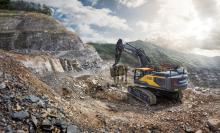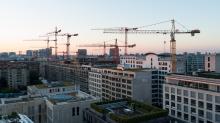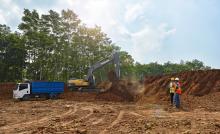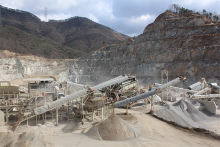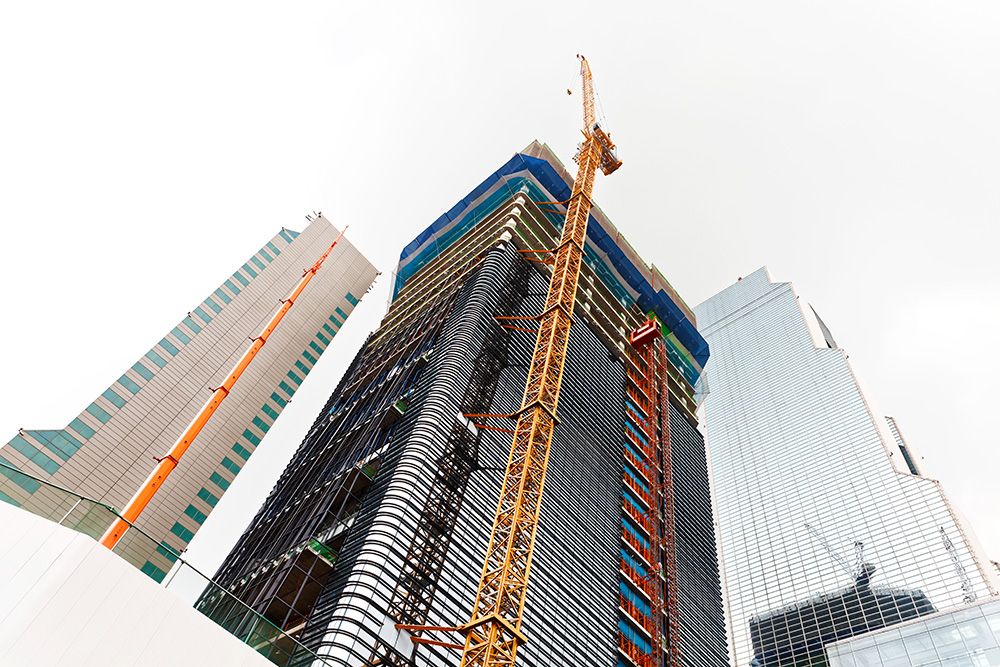
South Korea’s aggregates sector is gradually recovering to pre-COVID levels of production, but ongoing challenges remain including a slowing domestic construction market and increasing materials prices.
Willis Rooney, economist at GlobalData, says the South Korean construction industry shows a continued weakness, with low external demand and a slowing of consumption growth likely to weigh on new investment in the short term. This directly impacts on demand for quarry and aggregates products in the country.
The construction industry in South Korea registered marginal growth of 0.2% in real terms in 2022, according to GlobalData research. This followed four successive years of decline.
“The industry’s growth was constrained by the impact of multi-year high rates of inflation, the aggressive unwinding of monetary support by the Bank of Korea and the slowing global economic growth on new construction demand,” says Rooney. “These factors are expected to continue to weigh on the construction activity in South Korea this year, though full-year growth will pick up to a marginal expansion of 0.8%.”
Cho Byoungyoung, head of marketing & retail support, KSS at Volvo Group Korea, says there are indications of gradual recovery in the country’s aggregates sector.
Last year the actual supply and demand for aggregates decreased by 4.8% compared to 2021, with a total of 232,190,000 m3 of aggregate supplied, according to data contained in the Ministry of Land, Infrastructure and Transport’s ‘Aggregate Supply and Demand Plan’.
However, Cho states: “Despite this decrease, the statistical data suggests that the South Korea quarrying and aggregates sector is on a path towards recovery, as aggregate demand in 2023 is expected to be 238,987,000 m3 based on the domestic construction investment forecast and the amount of aggregate input per billion won in construction investment.

“Although ongoing pandemic-related challenges may cause some fluctuations in production levels, the South Korean quarrying and aggregates sector is showing gradual signs of recovery. By observing this data, we can therefore conclude that the South Korean quarrying and aggregates sector appears to be on a path towards recovery, although there may still be some challenges and fluctuations in production levels due to ongoing pandemic-related obstacles.”
Market figures shared with Aggregates Business International by the World Cement Association show that cement production in South Korea rose slightly in 2022 to 46.8m tonnes from 46.7m tonnes in 2021, out of a total national capacity of 60.8m tonnes.
“The market situation is stable with only small changes in market share,” the WCA said in a statement.
The Global Aggregates Information Network (GAIN) says that aggregates demand in South Korea is driven mainly by new housing needs.
It adds that COVID restrictions have been lifted, and there is a determination in the administration of President Yoon Suk-yeol of the People Power Party that was elected in March 2022 to drive the economy forward.
“Access to aggregates resources is an ongoing challenge and marine aggregates are seen as a significant opportunity,” GAIN states.
In a report published in February this year by the Korean Society of Economic and Environmental Geology, authors Sei Sun Hong and Jin Young Lee wrote that, of the total aggregates produced in the country in 2021, 47 million m3 was sand and about 88 million m3 was accounted for by gravel.
The report states that the main sources of aggregates in the country have recently come from screening crushed aggregate and forest aggregate.
It estimates that of the 135 million m3 of aggregates produced in South Korea in 2020, about 49.6% came from screening crushed aggregate, 36.8% from forest aggregate, 2.6% from land aggregate, 6.8% from sea aggregate, 2.6% from washing, and 0.2% from river aggregate.
In 2021, aggregates were produced in 148 local government areas. The 10 leading producing local governments were, in descending order of volume, Hwaseong, Ongjin, Paju, Pocheon, Gwangju, Youngin, Cheongju, Gimhae, Anseong, and west EEZ. The combined production of the ten leading local governments accounted for 30% of the national total, and 47 local governments produced more than 1 million m3 of aggregates.
In terms of quarrying equipment that is popular in the country Chris Sleight, managing director of Off-Highway Research says that there is strong demand for wheeled excavators in South Korea. He adds that they replace some of the demand which is more usually met by crawler excavators in many other countries.
Cho says that South Korean quarry operators are particularly interested in purchasing excavators and wheeled loaders that meet the requirements set out in ‘Article 19’ of the ‘Enforcement Decree of the Aggregate Extraction Act.’
“The trend seems to be moving towards the purchasing of larger equipment with higher performance capabilities to meet the goal of reducing labour costs that have risen significantly due to the COVID-19 pandemic and improving productivity,” he says.
In addition, quarry operators are looking to lower the number of worksite accidents by reducing the number of workers onsite by using larger and more robust equipment. Cho says this is due to the introduction of the ‘52-hour workweek system’ across all workplaces in July 2021 and the ‘Severe Accident Punishment Act’ which took effect in 2022.
“By enlarging equipment, quarrying operators can reduce the number of workers required, which, in turn, can help reduce the likelihood of worksite accidents,” he says.
“These factors have shifted the specific type of quarrying equipment that South Korean quarry operators are interested in purchasing, particularly larger excavators and wheeled loaders with specifications that meet these legal requirements.”
The South Korean aggregates sector is being impacted by state policies on sustainability, and the government’s aim for a net-zero society. Environmental, social and governance (ESG) management is being highlighted to realise carbon neutrality, resulting in the need to minimise resource waste and promote resource circulation-type construction because, compared to other industries the construction industry has higher carbon emissions.
“This means it is now necessary to utilise recycled aggregates actively to improve and strengthen ESG management in the construction industry while changes in government policies are also required to secure sustainable aggregate resources,” says Cho.
The South Korean construction industry declined by 0.5% in 2022, according to estimates by ResearchAndMarkets. This followed contractions of 2.6% in 2021 and 1.3% in 2020.
The research company said the industry's downturn in 2022 was primarily caused by a combination of rising construction costs, rising inflation, higher energy prices, and increased supply chain disruptions influenced by China's zero-COVID policy. According to the Korean Statistical Information System (KOSIS), the construction industry's value-add declined marginally by 0.2% in the first three-quarters of 2022, decreasing from KRW61.2 trillion (US$48.8bn) during January-September 2021 to KRW61 trillion (US$48.6bn) during January-September 2022.
In addition, these disruptions had a significant impact on infrastructure and energy development projects, and consequently on aggregates and quarrying demand. The infrastructure construction sector contracted by 4.9% and the energy and utilities construction sector by 4.2%, respectively. Despite these persistent headwinds, ResearchAndMarkets says the construction industry is expected to record growth of 0.8% in 2023, aided by industrial project development.
In July 2022, the government committed to provide financial and regulatory support to pave the way for the semiconductor industry to invest KRW340 trillion (US$271.1bn) over the next five years.
The construction industry is expected to record an annual average growth of 4.1% between 2024 and 2026, supported by the development of transportation, energy, residential, and commercial projects. In 2021, the Korean government announced it plans to invest KRW114.7 trillion (US$91.4bn) in order to expand the railway network from its current 4,274km to 5,137km by 2030.
Furthermore, Hyundai Merchant Marine announced a five-year investment plan worth more than KRW15 trillion (US$12bn) in July 2022 to expand its South Korean logistical base.
In terms of the major current opportunities for quarrying-equipment providers in South Korea such as Volvo CE, Cho says the trend following the five-day work week and the Severe Accident Punishment Act has resulted in an increased preference for high-quality, large-sized equipment. He says this has been gradually increasing in the stone industry to reduce labour costs. “This presents an opportunity for Volvo CE to promote its large excavators and wheeled loaders, which are ideal for use in quarrying and mining operations,” he adds.
Cho says that articulated haulers are popular in quarrying and mining sites due to their excellent and reliable work performance, high productivity, low fuel efficiency, and strong durability. This creates an opportunity for Volvo CE to market its articulated haulers to complement its large excavators and wheeled loaders, potentially leading to increased sales in the South Korean market.
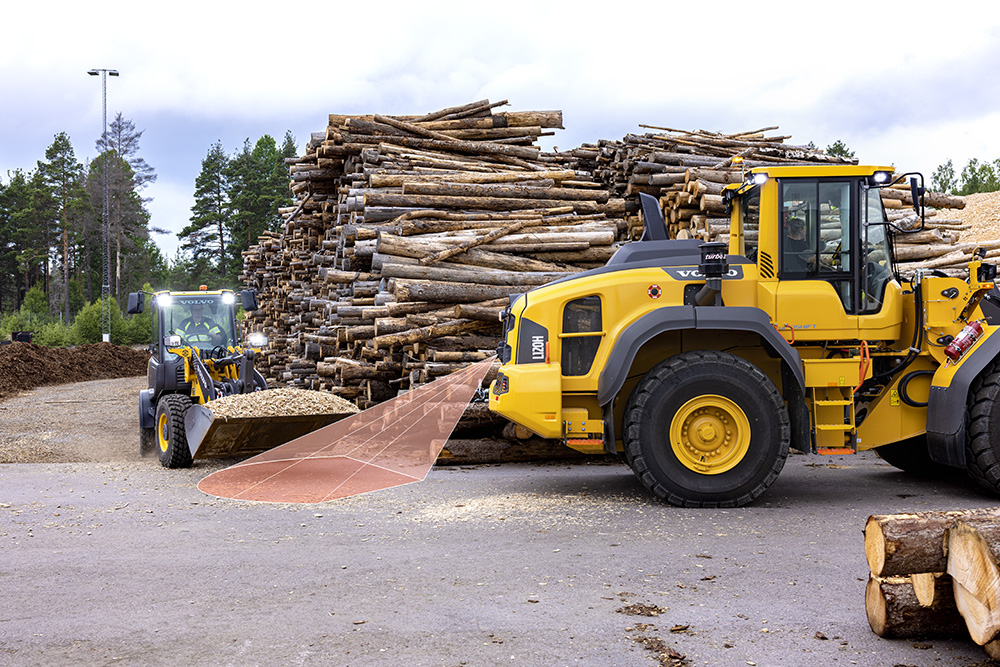
Over the next 18 months, Cho says the South Korean quarrying- and aggregates-equipment sectors are expected to experience major developments centred mainly around the need for equipment that prioritises productivity and safety. This is in response to the large demand for the aggregate supply required for the government-sponsored Social Overhead Capital (SOC) infrastructure construction projects from 2023.
“We predict that this is likely to result in accelerated equipment development and innovation in equipment design, technology and maintenance - presenting a potential shift towards equipment that is more sustainable and environmentally friendly,” says Cho.
Also impacting the materials sector are the steps being taken by the South Korean government to address safety concerns in the construction industry by revising the Aggregate Collection Act’s Enforcement Decree in 2023. This is in response to an accident at a construction site in Gwangju City. The revised decree aims to strengthen the quality-control standards for aggregates and prevent similar accidents from happening in the future.
Cho states that, while this may result in stricter quality-control standards, it may also potentially lead to a reduction in aggregates supply and demand which, in turn, may impact the demand for construction equipment.
“While this may impact the quarrying/aggregates sector, the full extent of its impact remains to be seen and will depend on various factors including the specifics of the revised standards and how they are implemented and enforced,” he adds.
The South Korean Ministry of Land, Infrastructure and Transport is taking a number of measures to address the decreasing trend of natural aggregate sources and improve the promotion of recycling construction waste in the country. One of these is the passing of the Act on Promotion of Recycling of Construction Wastes (Act No. 17939), which was enforced on June 17, 2021.
In response to these efforts, Cho says the quarry industry is actively promoting the development of technologies to improve the quality of recycled aggregates.
“While the current usage rate stands at only 14.6% as of 2022, new technology that lowers the variability of recycled aggregate quality and meets the strengthened quality control standards is being developed rapidly,” he says.
“As a result, the usage rate of recycled aggregate is expected to accelerate at a rapid pace in the near future. We believe this is an important step towards sustainable development in the construction industry, and it will likely have a significant impact on the quarrying industry in South Korea.”
As part of its sustainability and electrification efforts in South Korea, Volvo CE has announced an investment into battery-pack production at its excavator plant in Changwon.
With the SEK80m (US$7.8m) investment from Volvo Group, a new production facility and equipment will be built at the Changwon plant – which at around 1.1m m2, is the largest excavator production site in Volvo CE, producing around 55% of its total excavator volumes.
The new facility at the Changwon plant will produce a wide range of common electric-storage solutions (battery packs) for Volvo Group and become a core competence centre for electric excavators. This will enable Volvo Group to offer more sustainable solutions to its APAC markets in a more flexible, cost-effective and agile way and include supply chain, manufacturing and logistics.
Andy Knight, head of operations excavator and managing director of Volvo Group Korea, says: “As the largest plant in Volvo CE and the core site for excavator development and production, Changwon is at the forefront of our shift to a sustainable future.
“This investment is an important milestone in our electrification roadmap and supports our recent investments in production facilities for electric excavators. Changwon is ideally located close to battery-module supply partners and other key suppliers in South Korea to meet the needs of customers in the future. We are also home to a highly skilled and motivated workforce who are fully committed to meeting our future environmental targets.”
The new production facility will be built inside the current component workshop at Changwon – without disruption to the existing operation. Once complete, the facility will be approximately 2,500m2, including assembly and logistics areas. The building work will begin in April 2023, with battery-pack production expected to commence in June 2024.


